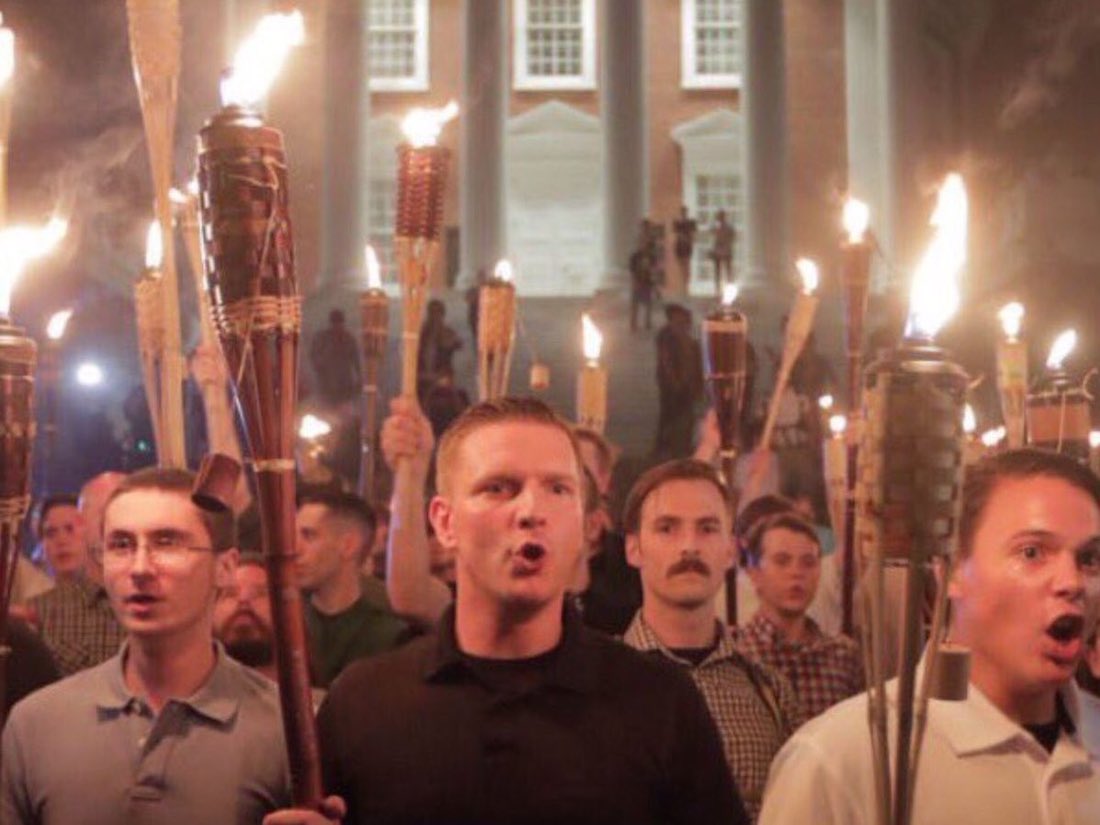Tiki Torches, Bedsheets, and ‘Very Fine People’ on Both Sides
UCSB Prof Pens Yale Letter Demanding Treasury Czar Resign

Years ago, I was forced to embrace my inner honky by circumstances far beyond my control. Early on in our courtship, my wife concluded I was, in fact, “too white for polka.” Hitherto, such a diagnosis had been deemed a scientific impossibility. As early as age 6, my daughter had taken to calling me “pink man.” Little wonder I was destined to found such august organizations as Honkies United for Hope (aka HUH?) and White Trash Forever (WTF?). With the nation now debating whether “very fine people” can really find common ground with tiki-torch-wielding goose steppers and domestic terrorists who wrap themselves in bedsheets — nothing but the finest, high-fiber-count percale cotton, I’m sure — my heritage has given me a head start in coming to terms with the legacy of Robert E. Lee.
Growing up upside the Mason–Dixon line in the suburbs of D.C., Robert E. Lee was hardly a stranger in my house. In fact, he all but came to dinner. My two oldest brothers, it turns out, were stark raving Civil War fanatics, dragging vast graveyards of old bones from nearby Civil War battlefields into our front yard and amassing large enough stockpiles of minié balls, bullets, canteens, and bayonets to credibly reenact the Battle of Antietam. In my family, there was God, Abraham, and Moses. After that, there was Robert E. Lee. They all had long, wavy white hair and full, billowy white beards, and — at least according to the statues — well-defined and manly pectorals. Each radiated patriarchal wisdom and compassion. Aside from Lee’s tragic nobility and all that mournful honor, they were interchangeable. Who knew that years later — just two weeks ago — Lee’s shaky perch on posterity would trigger a haters’ ball over race that left one woman and two cops dead and 19 wounded in Charlottesville, Virginia, and the president of the United States with his tongue firmly inserted, yet again, into the nearest light socket.
The sight of statues being toppled by angry mobs, I must admit, conjures mental reruns of the Taliban sacking historic temples to erase past glories. But Lee’s legacy — slavery, lynching, and Jim Crow — cries out not so much for eradication, but for a radical makeover based on the real man, not the sanctified myth stiff. The real Robert E. Lee, we find out, was a man of tiny feet, which he delighted in having his daughters tickle. He famously dreamed of fried chicken — a sprawling lifetime of it — but was accompanied as general by a pet hen whom he never ate because she was smart enough to lay an egg by his Spartan cot every morning.
When Lee encountered a soldier whipping his horse in battle, he counseled, “Don’t whip him, captain. It does no good. I had a foolish horse, once, and kind treatment is the best.” But with his own slaves, there was little such kindness. When Lee took over his own estate, slaves there had been led to believe they would be freed immediately upon the death of Lee’s predecessor. Lee saw it differently, sparking a near revolt. Lee dealt harshly with his own rebels, ordering them lashed within an inch of their lives and then buckets of briny water splashed upon their lacerated backs. Lee’s predecessors took pains to maintain the family integrity of his slaves; Lee, in sharp contrast, split up his slave families, maximizing the rent-a-slave possibilities by leasing them out hither, thither, and yon. Slavery, he would write, was bad for the white race; but blacks, he insisted, were immeasurably better under slave conditions than in Africa. “The painful discipline they are undergoing is necessary for their instruction as a race …”
As a white guy, I don’t want Lee removed. I just want him taken off Traveler, his round-rumped horse — the name, by the way, of the horse ridden by Tommy the Trojan after every USC touchdown — and replaced by new statues showing him accompanied by his pet hen and carrying a bucket of brine. No less unlikely — but much more directly — UCSB lecturer James Donelan engaged in the cultural war debate by penning the letter demanding that Treasury Secretary Steven Mnuchin resign immediately to save what’s left of his soul. Donelan and Mnuchin both graduated from Yale in 1985, and it was Mnuchin’s ill fortune to stand next to Donald Trump as the prez insisted that some of the alt-white protesters were otherwise “very fine people” concerned about Robert E. Lee.
Donelan, assistant director of the Writing Program, was appalled and was part of a spontaneous Facebook uprising made up of Yale’s Class of ’85. “We can be Republicans, Democrats, Libertarians, Greens, and a number of other things and still be friends, classmates, and patriots, but we cannot be Nazis and white supremacists,” Donelan wrote. Within just two days, more than 300 fellow graduates had signed his letter to The Mnooch. “We call upon you, as our friend, our classmate, and as a fellow American, to resign in protest of President Trump’s support of Nazism and white supremacy.”
Predictably, The Mnooch declined and vigorously defended Trump as an anti-racist. But it was more astonishing he responded at all. “How many Secretaries of the Treasury felt the need to write a letter defending themselves against demands for their resignation?” Donelan wondered.
In the meantime, Trump himself is doubling down on hate, denying any equivocation about Nazis, neo or otherwise, while accusing the Politically Correct of setting their sights on President Teddy Roosevelt. In previous interviews, Trump famously described his battle with venereal disease as his “personal Vietnam.” His statements this week suggest he lost that war and that the dementia induced by VD clearly won.
I have but two reactions.
HUH?
WTF?



